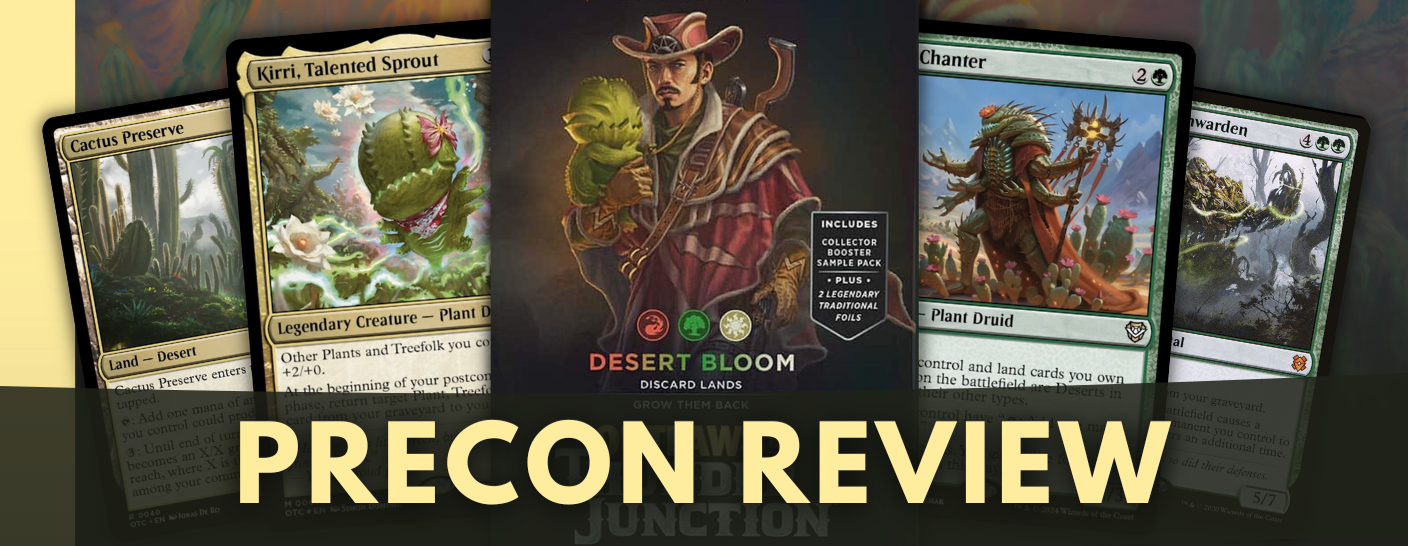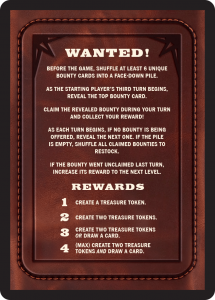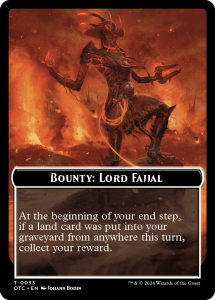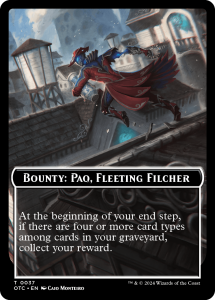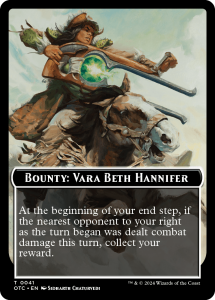Howdy partners! (I'll only do that once, I promise.) Welcome back to EDHREC for more precon guides. Outlaws of Thunder Junction has got everyone saddling up for some old-town throwdowns, so we’re here to give you all the dirt on this latest set of preconstructed Commander decks. And we’re kicking things off with Desert Bloom, the red, green, and white deck led by Yuma, Proud ProtectorYuma, Proud Protector.
Who Are the Commanders for Desert Bloom?
Yuma is a 6/6 Human Ranger for eight mana (woof!), but thankfully he costs one less for each land card in the yard. Whenever he enters or attacks, we can sacrifice a land to draw a card, and whenever a Desert is put into our yard, we make a 4/2 Plant Warrior creature token with reach.
Alright, so we’re throwing lands in the yard and making an army of poky, yet strangely adorable, Plant dudes. What else?
Our backup singer is Kirri, Talented SproutKirri, Talented Sprout, a 0/3 Plant Druid that shouts “Ya ha ha!” whenever it hits the board. It also gives all of your Plants and Treefolk +2/+0 (strange that Treefolk are included in this, since they usually prefer a boost to their defenses) and at the beginning of your postcombat main phase you can return a Plant, Treefolk, or land from your graveyard to your hand. So Yuma trashes the lands and Kirri brings them back. Sounds like a solid team-up.
Here’s the full decklist:
Desert Bloom Precon
View on ArchidektCommander (1)
- 1 Yuma, Proud ProtectorYuma, Proud Protector
Creatures (27)
- 1 Ancient GreenwardenAncient Greenwarden
- 1 Angel of IndemnityAngel of Indemnity
- 1 Angel of the RuinsAngel of the Ruins
- 1 Avenger of ZendikarAvenger of Zendikar
- 1 Dune ChanterDune Chanter
- 1 Eccentric FarmerEccentric Farmer
- 1 Elvish RejuvenatorElvish Rejuvenator
- 1 Genesis HydraGenesis Hydra
- 1 Hazezon, Shaper of SandHazezon, Shaper of Sand
- 1 Kirri, Talented SproutKirri, Talented Sprout
- 1 Nantuko CultivatorNantuko Cultivator
- 1 Nesting DragonNesting Dragon
- 1 Omnath, Locus of RageOmnath, Locus of Rage
- 1 Oracle of Mul DayaOracle of Mul Daya
- 1 Perennial BehemothPerennial Behemoth
- 1 Ramunap ExcavatorRamunap Excavator
- 1 RumbleweedRumbleweed
- 1 Sand ScoutSand Scout
- 1 Satyr WayfinderSatyr Wayfinder
- 1 ScaretillerScaretiller
- 1 Scute SwarmScute Swarm
- 1 SkullwinderSkullwinder
- 1 Springbloom DruidSpringbloom Druid
- 1 Sun TitanSun Titan
- 1 Titania, Protector of ArgothTitania, Protector of Argoth
- 1 Turntimber SowerTurntimber Sower
- 1 World ShaperWorld Shaper
Sorceries (15)
- 1 Cataclysmic ProspectingCataclysmic Prospecting
- 1 DecimateDecimate
- 1 Descend upon the SinfulDescend upon the Sinful
- 1 Embrace the UnknownEmbrace the Unknown
- 1 Escape to the WildsEscape to the Wilds
- 1 ExploreExplore
- 1 Hour of PromiseHour of Promise
- 1 Magmatic InsightMagmatic Insight
- 1 Map the FrontierMap the Frontier
- 1 Requisition RaidRequisition Raid
- 1 Sevinne's ReclamationSevinne's Reclamation
- 1 Thrilling DiscoveryThrilling Discovery
- 1 Vengeful RegrowthVengeful Regrowth
- 1 Winding WayWinding Way
- 1 Wreck and RebuildWreck and Rebuild
Artifacts (5)
- 1 Arcane SignetArcane Signet
- 1 Chromatic LanternChromatic Lantern
- 1 Perpetual TimepiecePerpetual Timepiece
- 1 Sol RingSol Ring
- 1 Swiftfoot BootsSwiftfoot Boots
Instants (8)
- 1 Bovine InterventionBovine Intervention
- 1 Electric RevelationElectric Revelation
- 1 HarrowHarrow
- 1 Heaven // EarthHeaven // Earth
- 1 Path to ExilePath to Exile
- 1 Return of the WildspeakerReturn of the Wildspeaker
- 1 Unholy HeatUnholy Heat
- 1 Valorous StanceValorous Stance
Enchantments (4)
- 1 Bitter ReunionBitter Reunion
- 1 Crawling SensationCrawling Sensation
- 1 Marshal's AnthemMarshal's Anthem
- 1 The Mending of DominariaThe Mending of Dominaria
Lands (40)
- 1 Abraded BluffsAbraded Bluffs
- 1 Bristling BackwoodsBristling Backwoods
- 1 Cactus PreserveCactus Preserve
- 1 Command TowerCommand Tower
- 1 Conduit PylonsConduit Pylons
- 1 Creosote HeathCreosote Heath
- 1 Desert of the FerventDesert of the Fervent
- 1 Desert of the IndomitableDesert of the Indomitable
- 1 Desert of the TrueDesert of the True
- 1 Dunes of the DeadDunes of the Dead
- 1 Evolving WildsEvolving Wilds
- 7 ForestForest
- 1 Hashep OasisHashep Oasis
- 1 Jungle ShrineJungle Shrine
- 1 Krosan VergeKrosan Verge
- 1 Mirage MesaMirage Mesa
- 4 MountainMountain
- 1 Painted BluffsPainted Bluffs
- 6 PlainsPlains
- 1 Ramunap RuinsRamunap Ruins
- 1 Scattered GrovesScattered Groves
- 1 Scavenger GroundsScavenger Grounds
- 1 Shefet DunesShefet Dunes
- 1 Sheltered ThicketSheltered Thicket
- 1 Sunscorched DivideSunscorched Divide
- 1 Terramorphic ExpanseTerramorphic Expanse
What Are the Themes and Strategies of the Deck?
Getting lands in and out of the grave is the crux of this deck. It’s basically Lord WindgraceLord Windgrace’s whole shtick, but we’re switching black for white (which isn’t a huge loss, aside from The Gitrog MonsterThe Gitrog Monster and Squandered ResourcesSquandered Resources).
Obviously our two new legends excel at this game plan, but we can’t just rely on them. So the deck is full of ways to mill, discard, or sacrifice lands to the grave. Eccentric FarmerEccentric Farmer, Satyr WayfinderSatyr Wayfinder, Springbloom DruidSpringbloom Druid, HarrowHarrow, and Perpetual TimepiecePerpetual Timepiece are just a few of the reprints in the deck that can help us get lands to the yard.
But we don’t just want the lands to sit in the yard, even though they make Yuma cheaper; they’re much more useful on the battlefield. So for getting them back, we’ve got Hazezon, Shaper of SandHazezon, Shaper of Sand (who could technically lead the deck, if one were so inclined), Ramunap ExcavatorRamunap Excavator, World ShaperWorld Shaper, Perennial BehemothPerennial Behemoth, ScaretillerScaretiller, The Mending of DominariaThe Mending of Dominaria, and the highest value reprint in the deck, Ancient GreenwardenAncient Greenwarden.
With as many lands as we have entering the battlefield, it seems like the perfect place for some Landfall abilities as well. To go along with our token theme, we’ve got Scute SwarmScute Swarm, Nesting DragonNesting Dragon, Avenger of ZendikarAvenger of Zendikar, and Omnath, Locus of RageOmnath, Locus of Rage, with Ancient Greenwarden doubling our Landfall, and any other land-entering triggers. And for even more tokens, there’s Titania, Protector of ArgothTitania, Protector of Argoth, Turntimber SowerTurntimber Sower, and Crawling SensationCrawling Sensation.
A point of contention for many Commander players is how many lands to run in a deck. In this precon we’ve got 40, which would usually cause many scoffs from the seasoned players. But when we consider that many of our lands will end up in the yard, and that we also still need mana to cast spells, 40 actually seems like the bare minimum. And let’s not forget that important caveat with Yuma’s token-making ability. It can't be just any land going to the yard; it has to be a Desert. Of our 40 lands, 15 are Deserts (according to Scryfall, our max possible would be 25). One of the inclusions is Scavenger GroundsScavenger Grounds, which seems a bit contradictory, considering that exiling our graveyard would be an absolute last resort with our deck’s themes. But I guess it’s always nice to have. Some of the Deserts even have sacrifice outlets built in: Hashep OasisHashep Oasis, Ramunap RuinsRamunap Ruins, and Shefet DunesShefet Dunes.
How Do You Play Desert Bloom?
Finding a good opening hand with this deck can be tricky. You definitely feel the 40 lands when you’re trying to shape a good start to the game. With each playtest I had to mulligan at least once, but usually twice. It’s important to find that sweet spot with not too many lands, and spells you can cast early.
Aside from that, the deck is pretty easy to play, except for one thing: Yuma. That eight-mana cost, even with the reduction, is a pretty significant hindrance to the deck’s plan. Could Yuma have been one or two mana cheaper without being broken? Absolutely. He’s really not strong enough to warrant such a high cost, but when you have games where you struggle to get Deserts in the yard, his absence is really felt. There’s not really much you can do about this, aside from more aggressive mulliganing.
How you win with this deck isn’t exactly evident at first glance. While it may seem to focus on lands, the real strength is in its ability to make tokens. Unfortunately, there’s not enough of a way for you to win with those tokens, aside from RumbleweedRumbleweed and Return of the WildspeakerReturn of the Wildspeaker. But it feels like it’s not enough. I even struggle to say that Return of the Wildspeaker is good in this deck, since Yuma is a Human and of no help with either mode of the spell.
The biggest thing this deck does successfully is graveyard recursion. Cards like Sun TitanSun Titan and Sevinne’s ReclamationSevinne’s Reclamation work beautifully to bring back lands and other low-mana permanents. And then there are cards that allow us to play lands from the yard, like Hazezon, Shaper of SandHazezon, Shaper of Sand, who is an absolute powerhouse in this deck, Perennial BehemothPerennial Behemoth, and Ramunap ExcavatorRamunap Excavator. Wizards wasn’t bold enough to give us a Crucible of WorldsCrucible of Worlds reprint in this precon, but we can definitely make do with what we have here.
What Are the New Cards in Desert Bloom?
Okay, a lot of you are here for just one reason: new cards. So I won’t keep you waiting any longer. In addition to the two legends that can lead the deck, we’ve got eight new cards in the pack, plus three bounties (more on bounties in a bit).
Let’s start in the desert, with Cactus PreserveCactus Preserve, a Reflecting PoolReflecting Pool that, sadly, enters tapped. For three mana you can turn it into a Plant creature with reach and p/t equal to the highest mana value among your commanders. In this deck, it’ll be an 8/8 (or a 10/8 if Kirri is on the field).
For creatures, we have Dune ChanterDune Chanter, a Plant Druid that turns all of your lands, on the field and off, into Deserts. This is a huge ability for this deck by itself, but there’s much more. It also has a Chromatic LanternChromatic Lantern effect, and you can tap it to mill yourself for two and you gain a life for each land milled. This might be the most important card in the deck. There’s also Angel of IndemnityAngel of Indemnity, which is a 5/5 with flying and lifelink that returns a permanent card in your graveyard with MV four or less from the grave to the battlefield when it enters. The icing here is that it has Encore (although it’s a bit pricey), so in the late game you can activate it to get three copies of the Angel swinging (assuming all players are alive), with a gain of 15 life and three permanents back from the grave. A lot of potential here for Blink or Reanimator decks.
RumbleweedRumbleweed has a mighty price tag, but it’s discounted for every land card in the yard. On first glance it might look like a weaker Craterhoof BehemothCraterhoof Behemoth, but without that haste keyword, it’s actually closer to End-Raze ForerunnersEnd-Raze Forerunners. Make no mistake, Forerunners absolutely ends games if you’re willing to run it, as will Rumbleweed. But it’s hard to skip Craterhoof, unless you’re on a budget. Our last new creature is Sand ScoutSand Scout, a 2/2 for two mana that’s basically a Desert-fetching Knight of the White OrchidKnight of the White Orchid on entry, with the extra bonus of making tokens when lands enter our grave.
The rest of the new cards are all sorceries. Cataclysmic ProspectingCataclysmic Prospecting seems like a pretty typical X spell, except, as far as I can tell, it’s the only X spell that hits all creatures and doesn’t also hit players. This can be pretty significant if you’re looking to wipe the board without hurting yourself in the process. The Treasure is certainly an added bonus, but the card won't be significant outside of this and Hazezon decks.
Vengeful RegrowthVengeful Regrowth gets you three lands and three 4/2s for six mana. Seem like a pretty solid ROI, even with the lands entering tapped. Paying eight for the Flashback, however, seems like something you’d only do in desperation. But keep in mind there’s a decent amount of mill in the deck, so the card has a good chance of ending up in the yard without being cast.
Last there’s Embrace the UnknownEmbrace the Unknown, a decent impulse draw effect. The only true benefit is the Retrace ability, which allows you to cast it from the grave by discarding a land. The most important part of the Retrace effect is that it’s repeatable. Unlike many cast-from-graveyard effects, it doesn’t exile itself after you cast it. So you can cast it over and over if you’ve got the mana and lands in hand.
What Are Bounties?
Each of the Thunder Junction precons comes with three bounty cards that exist in the game outside of your deck. They’re basically a mini-game that all players participate in, where you’re supposed to “catch” that character by satisfying their requirement by the end of your turn.
There’s a shared bounty deck of at least six bounties that get shuffled up at the beginning of the game. Each bounty card has the same four levels of rewards:
- Create a Treasure
- Create two Treasures
- Create two Treasures or draw a card
- Create two Treasures and draw a card
At the beginning of the starting player’s third turn, you flip the top card of the bounty deck. If that player meets the requirement on the bounty (you can only claim a bounty on your turn), they get the first reward. If they don’t, the next player can win the bounty, but they’ll get the second reward, and on. If the fourth player doesn’t get it, the bounty stays in play, but the reward stays at the fourth level until it’s claimed. Once claimed, the next player flips the next bounty and it starts over at the first reward level. When all bounties in the deck are claimed, you shuffle them all up and start again.
Each bounty has its own specific requirement. The Desert Bloom deck has the following:
- Lord Fajjal - at the beginning of your end step, if a land entered your grave from anywhere, collect
- Paq, Fleeting Filcher - at the beginning of your end step, if there are four or more card types in your grave, collect
- Vara Beth Hannifer - at the beginning of your end step, if the nearest opponent to your right as the turn began was dealt combat damage, collect (the “as the turn began” language is important here in case that opponent is knocked out of the game during your turn)
Will we see bounties again beyond this set? Hard to tell. The most obvious correlation is planechase cards, which we’ve now seen in a few sets. Bounties are certainly much less game impacting than planechase, but if they’re popular, and if it makes sense thematically, we’ll surely see more of this mini-game.
Is Desert Bloom Worth Buying?
Is the deck any good? Here’s my final grade:
B-
This deck has a lot working in its favor, particularly its synergy and new cards. There are several new cards here that will see play not only in Desert decks like this and Hazezon, but in other lands decks like Lord WindgraceLord Windgrace and Thalia and The Gitrog MonsterThalia and The Gitrog Monster. This is the only precon I can recall where there weren't new cards that I immediately wanted to take out for upgrades. And I feel like that’s saying a lot.
The deck does a really solid job of doing what it sets out to do, which is moving lands to and from the graveyard. I just wish it had some more ways to win. And that the commander was cheaper.
From a value standpoint, the reprints here are decent. The biggest win is definitely Ancient GreenwardenAncient Greenwarden, but we’re also happy with Oracle of Mul DayaOracle of Mul Daya, Ramunap ExcavatorRamunap Excavator, and Scute SwarmScute Swarm.
Can I make this deck better? Find out in my upgrade guide, here on EDHREC. Thanks for reading!
More Precon Fun:
Heavenly Inferno - Kaalia Precon Upgrade
Andy Zupke
Andy's the editor in chief for the EDHREC blog content. He's been playing Magic on and off since Fallen Empires. He loves to travel, drink, eat, and spend time with family and friends.
Your opinions are welcome. We love hearing what you think about Magic! We ask that you are always respectful when commenting. Please keep in mind how your comments could be interpreted by others. Personal attacks on our writers or other commenters will not be tolerated. Your comments may be removed if your language could be interpreted as aggressive or disrespectful. You may also be banned from writing further comments.
